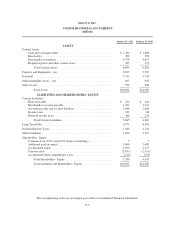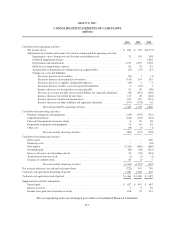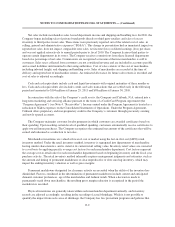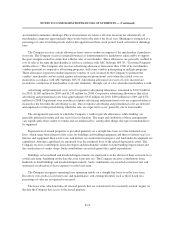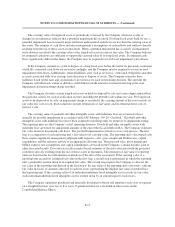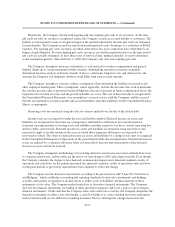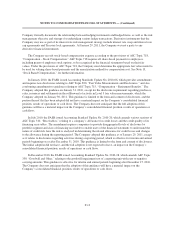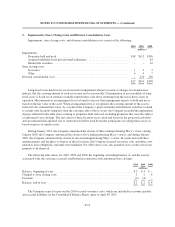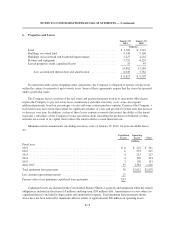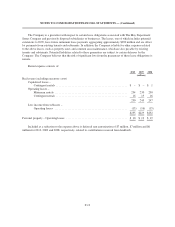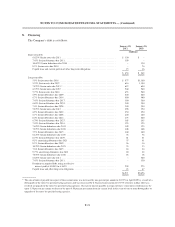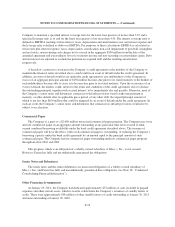Macy's 2010 Annual Report Download - page 63
Download and view the complete annual report
Please find page 63 of the 2010 Macy's annual report below. You can navigate through the pages in the report by either clicking on the pages listed below, or by using the keyword search tool below to find specific information within the annual report.
NOTES TO CONSOLIDATED FINANCIAL STATEMENTS — (Continued)
In February 2008, the Company began a localization initiative called “My Macy’s.” This initiative was
intended to strengthen local market focus and enhance selling service in an effort to both accelerate same-store
sales growth and reduce expenses. To maximize the results from My Macy’s, the Company took action, initially
in selected markets, that: concentrated more management talent in local markets, effectively reducing the “span
of control” over local stores; created new positions in the field to work with planning and buying executives in
helping to understand and act on the merchandise needs of local customers; and empowered locally based
executives to make more and better decisions. In combination with the localization initiative, the Company
consolidated the Minneapolis-based Macy’s North organization into New York-based Macy’s East, the St. Louis-
based Macy’s Midwest organization into Atlanta-based Macy’s South and the Seattle-based Macy’s Northwest
organization into San Francisco based Macy’s West. The Atlanta-based division was renamed Macy’s Central.
In February 2009, the Company announced the expansion of the My Macy’s localization initiative across
the country. As My Macy’s was rolled out nationally to new local markets in 2009, the Company’s Macy’s
branded stores were reorganized into a unified operating structure, through division consolidations, to support the
Macy’s business. Division central office organizations were eliminated in New York-based Macy’s East, San
Francisco-based Macy’s West, Atlanta-based Macy’s Central and Miami-based Macy’s Florida. The New York-
based Macy’s Home Store and Macy’s Corporate Marketing divisions no longer exist as separate entities. Home
Store functions were integrated into the Macy’s national merchandising, merchandise planning, stores and
marketing organizations. Macy’s Corporate Marketing was integrated into the new unified marketing
organization. The New York-based Macy’s Merchandising Group was refocused solely on the design,
development and marketing of the Macy’s family of private brands.
The costs and expenses associated with the division consolidations and localization initiatives consisted
primarily of severance costs and other human resource-related costs.
The following table shows for 2010, 2009 and 2008, the beginning and ending balance of, and the activity
associated with, the severance accruals established in connection with the division consolidations and
localization initiatives:
2010 2009 2008
(millions)
Balance, beginning of year ................................................... $69 $ 30 $ –
Charged to division consolidation costs ......................................... – 166 99
Payments ................................................................. (69) (127) (69)
Balance, end of year ........................................................ $ – $ 69 $30
The Company performed both an annual and an interim impairment test of goodwill and indefinite-lived
intangible assets during 2008 (see Note 3, “Goodwill Impairment Charges”). As a result of the then-current
economic environment and expectations regarding future operating performance of the Karen Scott, John
Ashford and Frango private brand tradenames, it was determined that the carrying values exceeded the estimated
fair values, which were based on discounted cash flows, and management concluded that asset impairment
charges were required.
The Company accounts for its investment in available-for-sale marketable equity securities with unrealized
gains and losses being included as a separate component of accumulated other comprehensive income. During
2008, based on the then-current economic environment, it was determined that the carrying value of certain
marketable equity securities exceeded the current fair value on an “other-than-temporary” basis, and the
previously unrecognized losses in accumulated other comprehensive income were reclassified into the
Consolidated Statements of Operations.
F-15


